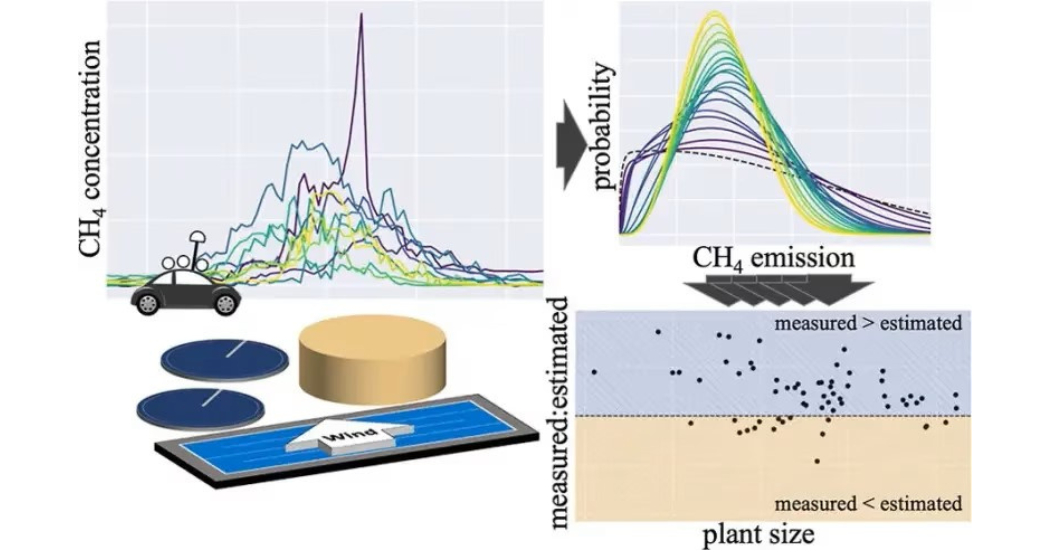Municipal wastewater treatment plants emit nearly double the amount of methane into the atmosphere than scientists previously believed, according to new research from Princeton University. And since methane warms the planet over 80 times more powerfully than carbon dioxide over 20 years, that could be a big problem.
“The waste sector is one of the largest anthropogenic sources of methane in the world,” said Mark Zondlo, professor of civil and environmental engineering and associated faculty at the Andlinger Center for Energy and the Environment. “As cities continue to urbanize and develop net-zero plans, they can’t ignore the liquid wastewater treatment sector.”
Zondlo led one of two new studies on the subject, both reported in papers published in Environmental Science & Technology. One study performed on-the-ground methane emissions measurements at 63 wastewater treatment plants in the United States; the other used machine learning methods to analyze published literature data from methane monitoring studies of various wastewater collection and treatment processes around the globe.
“Not many people have studied the methane emissions associated with wastewater infrastructure, even though we know that it’s a hotspot for methane production,” said Z. Jason Ren, who led the second study. Ren is a professor of civil and environmental engineering and the Andlinger Center for Energy and the Environment.
The Intergovernmental Panel on Climate Change (IPCC) has established guidelines that allow researchers and institutions like the U.S. Environmental Protection Agency (EPA) to estimate methane emissions from wastewater treatment plants based on their specific treatment processes. However, those guidelines were developed from limited measurements at a relatively small number of wastewater treatment plants.
When the researchers used the Princeton Atmospheric Chemistry Experiment (PACE) Mobile Laboratory to quantify plant-wide emissions by measuring the plumes of 63 treatment plants on the east coast and in California, they found that the IPCC guidelines consistently underestimated treatment plants of all sizes and treatment processes.
If the results from those 63 plants are representative, actual methane emissions from wastewater treatment facilities across the U.S. would be about 1.9 times greater than emissions estimates that use existing IPCC and EPA guidelines, meaning that those guidelines underestimate methane emissions equivalent to 5.3 million metric tons of carbon dioxide.

Graphical abstract: Environmental Science & Technology (2023). DOI: 10.1021/acs.est.2c05373
Interestingly, the research team who performed the second independent study to analyze literature data on methane emissions came to a similar conclusion: estimated methane emissions from municipal wastewater treatment in the U.S. were around double of what existing guidelines would predict.
“We were able to show, using two different approaches, that methane emissions are a much bigger issue for the wastewater sector than previously thought,” Ren said.
The usual suspects in wastewater methane emissions
The researchers believe that since the IPCC guidelines were developed from limited measurements at a small number of wastewater treatment plants, they might not accurately represent the variation in emissions that exists between facilities.
“The guidelines assume a certain level of efficiency in these wastewater treatment systems that may not exist on a plant-to-plant basis,” said Daniel Moore, first author of the direct measurement study and a graduate student in civil and environmental engineering. He pointed to leaks and inefficient equipment that may go undetected at wastewater treatment plants but could lead to significant greenhouse gas emissions.
Cuihong Song, first author of the critical review and a postdoctoral researcher in civil and environmental engineering at Princeton, said that treatment plants equipped with anaerobic digesters were among the biggest methane leakers.
Anaerobic digesters are airtight vessels containing anaerobic microbes that work without oxygen to break down wastewater sludge or solid waste and produce methane-rich biogas in the process. That methane can be used to generate heat or electricity to power other aspects of the treatment process.

Researcher Daniel Moore inspects the Princeton Chemistry Experiment Mobile Laboratory. Credit: Bumper DeJesus / Princeton University
But when anaerobic digesters operate inefficiently, leaks and pressure buildups can allow methane to escape as fugitive emissions. “If the digester is not gas-tight, you can end up with high methane emissions,” Song said. The researchers found that plants with anaerobic digesters emitted more than three times the methane than plants without digesters.
Higher emissions from anaerobic digesters could be a serious problem: While wastewater treatment plants equipped with anaerobic digesters account for less than 10% of all treatment plants in the U.S., most of those plants are large facilities that, combined, treat around 55% of the wastewater in the country.
“A lot of money is going into decreasing emissions by implementing these digesters, because, in theory, they’re closed systems. When they’re working correctly, you can centralize the methane into one location,” Moore added. “It’s the inefficiencies and leakages that cause many of the problems.”
Along with anaerobic digesters, the critical review found that methane emissions from sewer systems contribute significantly to nationwide methane emissions. However, current guidelines largely do not account for fugitive methane emissions from sewers, which the researchers said are important to account for in future greenhouse gas inventories.
“We have more than a million miles of sewers in the U.S., filled with rich organic matter that may be causing methane emissions, but we have very little understanding of their scope,” Ren said.
Better monitoring, better guidelines
The researchers are now working with partners to build an inventory and methodology that would allow managers to easily monitor their methane emissions. By identifying the sources in the wastewater treatment process that release the most methane emissions, their work can also inform efforts to mitigate fugitive emissions.
“Methane has a short lifetime in the atmosphere, so if we’re able to cut off the spout of emissions across the country, methane’s contribution to warming will quickly diminish,” said Moore. “Ten years from now, we wouldn’t have to worry so much about methane.”
Ren added that the methane produced from processes like anaerobic digestion also serves as a valuable energy source. “By identifying and mitigating fugitive methane emissions, we would see double benefits,” he said. “We would reduce greenhouse gas emissions in the near term, and we would maximize the amount of methane we can recover from the wastewater treatment process.”
Still, more work is needed to monitor methane emissions at various timescales from treatment plants and sewer networks of different sizes and treatment processes.
For example, few studies have performed long-term, continuous monitoring of methane emissions from wastewater treatment plants, even though the emissions rate can vary daily or even seasonally, being generally higher in the spring and summer than in the winter. “Ultimately, we need to have a full accounting of the emissions from plants across many timescales,” Zondlo said. He added that preliminary analyses of subsequent measurements from additional plants at various times of the year have highlighted the importance of understanding seasonal variation in emissions.
At the same time, researchers will need to develop better sampling methods to understand emissions from hard-to-reach areas like sewers, since the diffuse nature of sewer networks along with their high humidity levels make it difficult to capture an accurate picture of emissions with existing methodologies.
By overcoming those hurdles and continuing their monitoring efforts, the researchers could contribute to a wider effort to create updated guidelines that better estimate methane emissions from the wastewater sector.
“Many agencies are recognizing that methane emissions from wastewater sector are important to study,” Ren said. “This research is not just reporting our own findings. We’re echoing what the broader research community has observed and identified as a significant gap of knowledge.”
More information: Daniel P. Moore et al, Underestimation of Sector-Wide Methane Emissions from United States Wastewater Treatment, Environmental Science & Technology (2023). DOI: 10.1021/acs.est.2c05373
Cuihong Song et al, Methane Emissions from Municipal Wastewater Collection and Treatment Systems, Environmental Science & Technology (2023). DOI: 10.1021/acs.est.2c04388
Journal information: Environmental Science & Technology
Provided by Princeton University





Comments